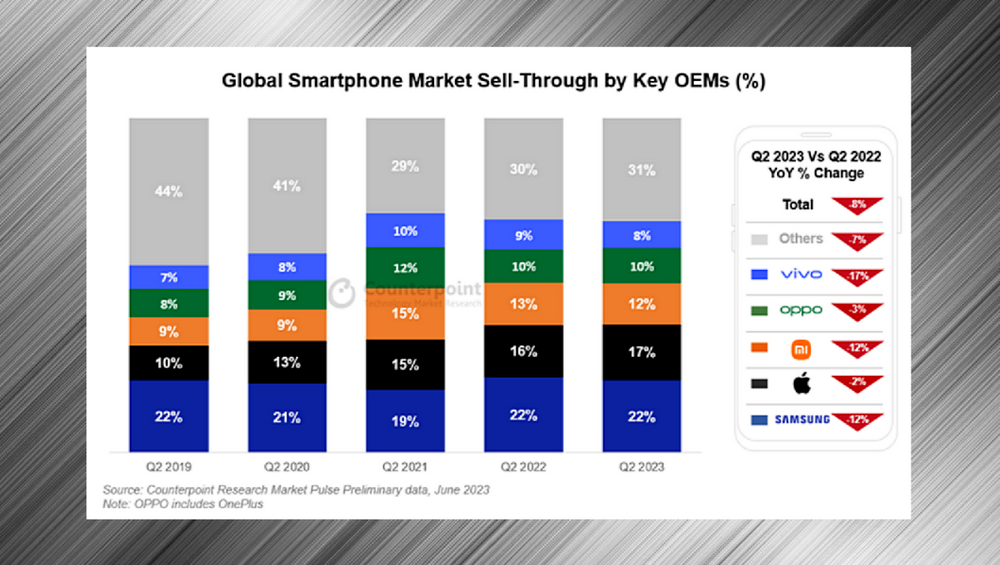Global Smartphone Market Enters Maturity As Consumers Desire More Premium Models
According to Counterpoint's Market Pulse service, the global
smartphone market experienced an 8% year-on-year decline and a 5%
quarter-on-quarter decline in the second quarter of 2023. This marks the
eighth consecutive quarter of year-on-year decline.
In terms of market share, Samsung led the market with 22%, benefiting from the
strong performance of its Galaxy A-series worldwide. Apple came in second
place, achieving its highest-ever market share for the second quarter. Xiaomi,
the third-largest brand, faced challenges in its major markets, China and
India, but is seeking to offset these declines by expanding into other markets
and refreshing its product lineup. OPPO performed relatively well in its home
market of China and India, thanks to OnePlus, managing to maintain its global
market share despite losses in Western Europe. vivo (including iQOO)
experienced significant growth declines in China compared to a strong second
quarter last year, and faced strong competition from Samsung and OPPO in the
offline markets of India and Southeast Asia.

Global Smartphone Market Has Matured
The global smartphone market appears to have moved past its period of rapid
growth, as consumer replacement cycles lengthen, device innovation converges,
and a more mature refurbished smartphone market emerges, particularly in the
lower- to mid-tier price segment.
However, the premium segment (smartphones priced at $600 or above wholesale)
continues to grow, as mature consumers opt for a superior experience and
finance options become readily available. The premium segment was the only
segment that experienced growth during the quarter, reaching its highest-ever
contribution to the overall market. More than one in five smartphones sold
during the quarter belonged to the premium segment.
Premiumization Era of Smartphones
Apple is capitalizing on this trend of "premiumization" and achieving record
shares in new markets that are typically not considered its core markets. For
example, it experienced a 50% year-on-year growth in Q2 2023 in India. The
strong performance of the premium segment has helped mitigate revenue declines
compared to sales volumes, prompting brands to invest in market expansion and
innovation in newer technologies.
Sales contracted in all regions worldwide, but the steepest decline occurred
in relatively more developed markets such as the US, Western Europe, and
Japan, all of which recorded double-digit annual declines. Markets in China,
India, and the Middle East & Africa experienced relatively smaller
declines. OEMs and channels attempted to clear excess inventory through
promotions and "big sale" festivals. However, demand remained weak due to
higher interest rates impacting disposable income in the US. In China, despite
aggressive promotions during the "618" premier sales event, the response was
lukewarm. Nevertheless, the event helped stabilize the decline in the Chinese
smartphone market and indirectly impacted the global market in June.
Despite these challenges, there is some positive outlook for the smartphone
industry. According to Counterpoint's Smartphone Inventory Tracker, global
smartphone inventory levels have reached healthy levels over the past four to
five months. This provides OEMs with breathing room to launch and promote
newer models in the second half of the year, encouraging consumers to upgrade
and accelerating the replacement cycle.
Overall, a slow recovery of the market is expected in the coming quarters.

